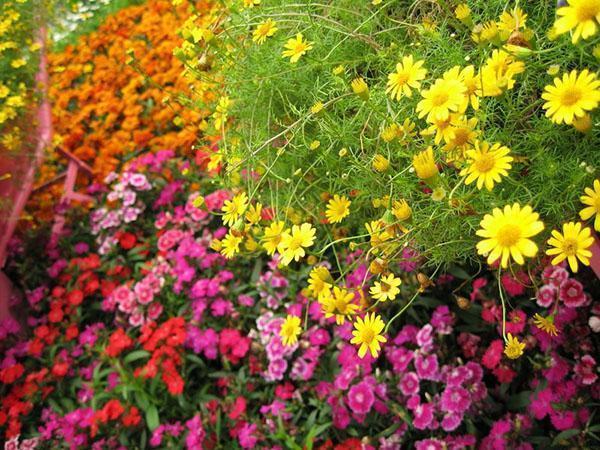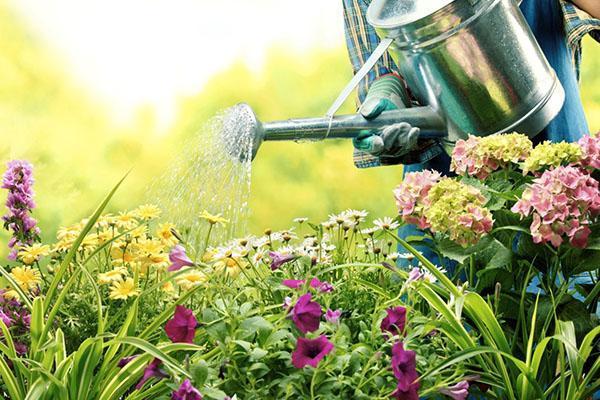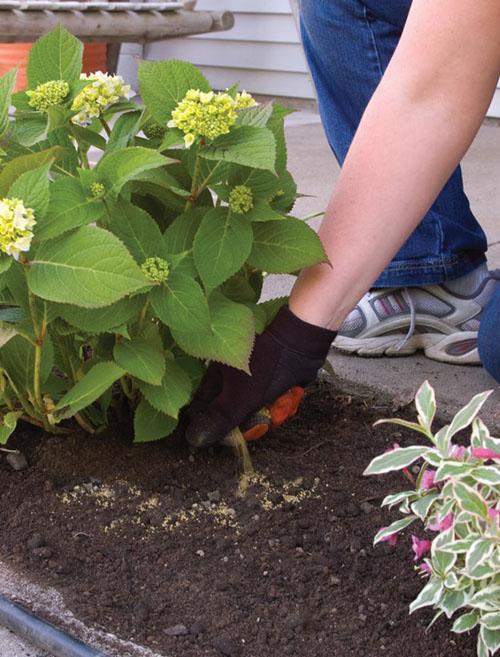Caring for perennial flowers in flower beds
 Having planted perennials, a florist can forget about seeds, seedlings and taking care of small seedlings that require special attention and care for several years. Already in the second year perennial flowers in the flowerbed the first to unfold the leaves in the spring, the first to open the corollas and become a garden decoration until the very frost. Their life in one place lasts more than one year, and, it would seem, does not require human participation. But you won't be able to get the full benefit from any, even the most non-capricious culture without regular and attentive care.
Having planted perennials, a florist can forget about seeds, seedlings and taking care of small seedlings that require special attention and care for several years. Already in the second year perennial flowers in the flowerbed the first to unfold the leaves in the spring, the first to open the corollas and become a garden decoration until the very frost. Their life in one place lasts more than one year, and, it would seem, does not require human participation. But you won't be able to get the full benefit from any, even the most non-capricious culture without regular and attentive care.
Like all plants, perennial flowers need watering and feeding. They can be interfered with by weeds, pests and diseases. And in the fall, it is worth making sure that green pets are protected from the coming winter frosts.
Watering perennial flowers

You can verify the need for watering by checking the condition of the soil in the flowerbed at a depth of 5–10 cm, that is, where the bulk of the moisture-absorbing roots is located. The frequency with which perennials should be watered and the amount of water per square meter depends on the crops planted and the type of soil.
On average, a florist pours 20 liters of settled, heated moisture per square meter of a flower bed:
- If the flower garden is in the shade, it is moistened much less often than one that is broken in the sun.
- On sandy soils, water retains worse than on loam or black soil, therefore perennials on sand are more fond of drinking.
- Planting perennials with a taproot system, for example, delphiniums, poppies, lupines or aquilegia, on the site, obliges the grower to pour more moisture under these flowers than under rudbeckia, coreopsis plants, phlox or feathery carnations.
Most of the rest, young, not yet overwintered plants with a weak root system, as well as lushly flowering specimens, spending all their energy on maintaining flowers and buds, depend on the regularity and quality of watering.
Watering flowers is carried out early in the morning or in the evening, when the sun is not so active as to leave traces of burns on wet foliage. If the weather is cloudy, there are no watering restrictions.
Weeding and loosening the soil under perennial flowers
 In order for the flowers to get all the moisture, the roots breathe and do not experience nutritional deficiencies due to the abundance of competitors nearby, the soil under the plants must be loosened and weeded. The complexity of this procedure is associated with a high risk of damaging the flowers with a hoe or other mechanical tool. A similar situation is not excluded when using chemical agents to combat unwanted residents of the flower bed.
In order for the flowers to get all the moisture, the roots breathe and do not experience nutritional deficiencies due to the abundance of competitors nearby, the soil under the plants must be loosened and weeded. The complexity of this procedure is associated with a high risk of damaging the flowers with a hoe or other mechanical tool. A similar situation is not excluded when using chemical agents to combat unwanted residents of the flower bed.
 Therefore, weeding of group plantings of overgrown perennial crops is carried out manually. The work is quite laborious, and experienced florists prefer to mulch the spaces between flowers. For this purpose, chopped mown grass, and coniferous bark chips, small pebbles or expanded clay are suitable. The latter materials, in addition to restraining the growth of weeds and protecting moisture, create an additional decorative effect and can be used as an independent garden decoration.
Therefore, weeding of group plantings of overgrown perennial crops is carried out manually. The work is quite laborious, and experienced florists prefer to mulch the spaces between flowers. For this purpose, chopped mown grass, and coniferous bark chips, small pebbles or expanded clay are suitable. The latter materials, in addition to restraining the growth of weeds and protecting moisture, create an additional decorative effect and can be used as an independent garden decoration.
Fertilization rules for perennials
 The life of perennials in one place leads to natural depletion of the soil. Therefore, such plants need competent support with the help of mineral and organic fertilizers:
The life of perennials in one place leads to natural depletion of the soil. Therefore, such plants need competent support with the help of mineral and organic fertilizers:
- The first term for feeding perennial crops begins immediately after the snow melts.
- Then the plants are fertilized when buds appear, during flowering and field of it.
- The last time organic matter is introduced in the last days of July, and from the second half of September this withdrawal is completely stopped.
The introduction of organic matter improves the quality of the soil and provides the plants with nutrition, but this happens very slowly.
So that the flowers do not feel a deficit of the "food" necessary for the development, the entire area of the flower bed, not occupied by plants in spring and autumn, is covered with a layer of well-rotted humus, cleaned of foreign inclusions. Mineral dressings are conveniently done with the help of granular mixtures, which in dry form are scattered under crops and penetrate into the soil with irrigation water.
Moreover, in the first half of the growing season, flowers need more nitrogen fertilizing, and closer to the end of the season, phosphorus and potassium prevail in fertilizers.
Pruning and garter flowering perennials
 To ensure the decorativeness of flower beds with perennials, in some cases the plants have to be tied up and pruned. Tall species with large inflorescences need supports, which, under their own weight, fall apart on the sides of the center of the outlet and lose their shape. Therefore, as they grow, such flowers are tied up, and faded or dried shoots are timely cut out.
To ensure the decorativeness of flower beds with perennials, in some cases the plants have to be tied up and pruned. Tall species with large inflorescences need supports, which, under their own weight, fall apart on the sides of the center of the outlet and lose their shape. Therefore, as they grow, such flowers are tied up, and faded or dried shoots are timely cut out.
For climbing crops, trellises or arches must be equipped that can support the weight of the plant and ensure its growth during the summer.
The purpose of pruning perennials is not only to maintain their sanitary condition, but also to prolong flowering, if possible. This method is effective against mallow, lupins and other species that set a lot of seeds and spend energy on their ripening.
 You can prune perennial flowers in spring or autumn. Specific dates are chosen depending on the timing of flowering of a particular culture. Pruning is often combined with transplanting and dividing adult plants.
You can prune perennial flowers in spring or autumn. Specific dates are chosen depending on the timing of flowering of a particular culture. Pruning is often combined with transplanting and dividing adult plants.
Preparing perennials for winter
In late autumn, perennials are prepared for wintering. To do this, cut out all dry parts, cover the soil with mulch or other insulating materials, make shelters for large specimens, or dig up the most thermophilic species for storage in the basement or at home.
If necessary, flower beds in winter are additionally covered with snow, which creates a powerful air cushion and actively protects perennials from freezing.